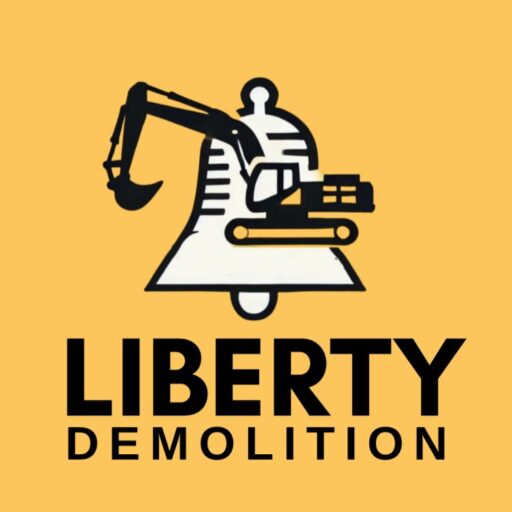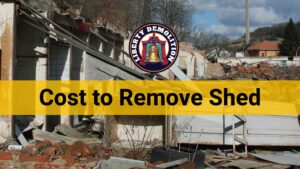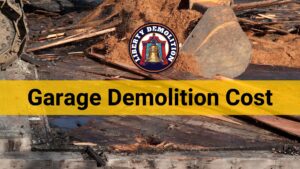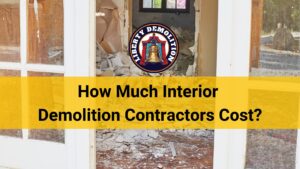Demolishing a house typically costs between $3,000 to $25,000, with the national average being around $18,000. The exact price is influenced by factors such as house size, geographic location, and the necessity for permits and inspections.
Curious about the breakdown of these costs? Continue reading to understand how much does it cost to demolish a house.
Cost Estimates Based on Size
Here’s a look at the costs you must prepare for depending on the size of your home:
1,200-square-foot House
For a house of this size, which can be typically considered a smaller to medium-sized home, the cost for demolition is estimated to range between $4,800 and $18,000. The wide range could be due to the presence of hazardous materials, the construction type, or local disposal fees.
3,000-square-foot House
This is a considerably larger home, potentially with multiple floors. The estimated cost of demolishing this structure ranges between $12,000 and $45,000. Again, the exact amount within this range would depend on various factors, including the house’s age, the materials used in construction, and the specific challenges posed by its location or design.
Cost and Significance of Permits
Typically, the permits required for a demolition project average between $50 and $100 each. However, the exact cost might vary depending on the locality, the complexity of the project, and the number of permits required.
Acquiring permits isn’t just a matter of cost. The necessity to obtain multiple permits and subsequent inspections can influence the timeline of a demolition project. For instance, before demolishing, one might need to hire a professional plumber to cap off utility lines and then wait for an inspection to verify the task has been done correctly.
Depending on the municipality, a single blanket permit might suffice, or there might be a need for several permits addressing different aspects of the demolition. It’s crucial to check with local government offices or agencies to get clarity on what’s required for a specific project.

Machinery
Machinery is a crucial element that determines the pace, effectiveness, and overall cost of the project. The choice between mechanical demolition and deconstruction is not only a matter of preference but also one that has significant implications on the cost, time, and environmental footprint of the project.
Mechanical Demolition
Mechanical demolition involves the use of large machinery to tear down structures. This method typically relies on heavy equipment like bulldozers, excavators, and wrecking balls to handle the bulk of the teardown process. Opting for mechanical demolition will increase the budget due to:
- Machinery Expenses. Renting or hiring heavy equipment has its associated costs.
- Specialized Labor. Operators of these machines require specific skills, often commanding higher wages than general labor.
- Time Factor. One of the primary advantages of mechanical demolition is speed. Since machinery can handle multiple sections of a structure swiftly, the overall project timeline is typically shorter compared to manual methods.
Deconstruction
Deconstruction involves manually dismantling a structure, often with the intention of salvaging and reusing materials. While deconstruction might seem like a cost-saving approach due to reduced machinery expenses, there are other financial considerations:
- Labor Intensity. Deconstruction is labor-intensive. The meticulous process requires more workers and longer hours compared to mechanical demolition.
- Extended Timeline. Given its nature, deconstruction takes considerably more time than mechanical demolition.
- Environmental and Ethical Benefits. Despite its cost implications, deconstruction can be viewed favorably due to its environmental benefits. By salvaging and recycling materials, it reduces waste, supports sustainable building practices, and minimizes the carbon footprint of demolition.
Mechanical Demolition vs Deconstruction
Mechanical demolition might appear more expensive upfront due to machinery and specialized labor costs. However, deconstruction can often match or surpass these costs due to its labor intensity and extended timeline.
Mechanical demolition is faster, while deconstruction is more time-consuming. However, deconstruction is more environmentally friendly as it promotes reuse and recycling, whereas mechanical demolition tends to generate more waste.
Geographic Location
The location of a house set for demolition plays an important role in determining the costs associated with the project. From accessibility challenges in bustling urban areas to the local economic landscape affecting labor and disposal fees, geographic location brings about a myriad of factors that influence the overall price.
Cleaning and Disposal
Demolishing a house is just one part of the project; what follows is the equally crucial task of cleaning up and disposing of the debris. This phase, while often underestimated, can significantly impact the overall cost of a demolition project.
Debris Removal
The amount of debris generated depends on the size of the house and the method of demolition. Furthermore, the nature of the debris (whether it’s bulk waste, recyclables, or hazardous materials) will dictate the disposal method and, consequently, the associated costs.
Every municipality has its own set of dumping fees based on its waste management infrastructure and local regulations. It’s not just the volume but the type of waste that determines these fees.
Beyond just the dumping costs, transporting the debris to disposal sites incurs additional expenses. This involves hiring dumpsters and potentially multiple trips, depending on the demolition’s scale. On average, the combined expenses for cleanup and disposal range between $300 and $1,800.
Hazardous Materials
Older homes, in particular, might contain hazardous materials such as asbestos, lead paint, or other harmful chemicals. Identifying and segregating these materials is a specialized task that can add to the costs.
Hazardous materials can’t be dumped with regular waste. Specialized disposal methods or facilities are needed, which invariably come with higher fees. Given the potential health risks, handling hazardous materials often requires specialized equipment and trained personnel, adding further to the cost.
Hauling Crews
In certain cases, particularly when the demolition contractor doesn’t include debris removal in their services, homeowners might need to hire a separate hauling crew. This can mean an added expense, generally around $400 to $600 for each truckload of waste.
Labor Costs
The cost, skill, and efficiency of the workforce play a pivotal role in determining the overall expense and quality of work. Understanding labor costs and their variables is essential for any homeowner planning a demolition.
Labor costs aren’t standardized across the country. Regions with a higher cost of living or where construction is in high demand often have higher labor rates. Similarly, areas with booming construction activity might experience inflated labor costs due to heightened demand.
Just like any industry, the construction and demolition sectors have their peak and off-peak seasons. Labor costs can rise during busy construction months and may decrease during off-peak times. Timing your demolition project during these less busy periods can potentially offer some cost savings.
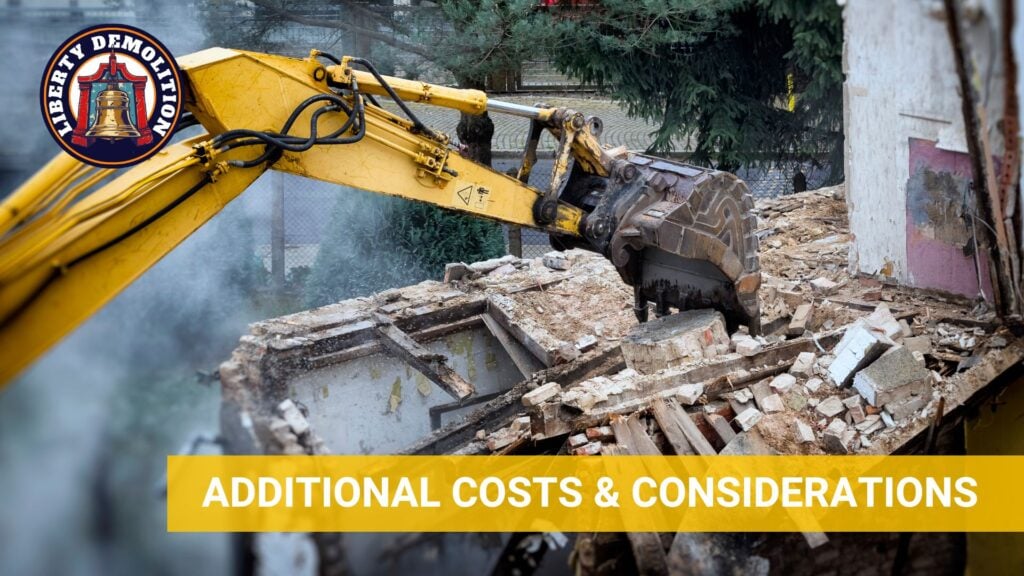
Additional Costs and Considerations
While the primary focus may initially be on the process of demolishing or deconstructing a house, it’s crucial to consider what comes next. The demolition represents one stage in a broader plan, especially if there’s no intention to sell the land post-demolition.
Cost to Eliminate Asbestos
Homes constructed before the 1990s are especially prone to containing asbestos in elements such as insulation, flooring, ceiling tiles, and paneling. Continuous exposure to airborne asbestos can lead to lung diseases, including asbestosis and mesothelioma, a form of cancer. Therefore, it’s crucial to ensure that any asbestos present in a home set for demolition is identified and managed appropriately.
Given the health hazards associated with asbestos, it’s important to engage professionals to handle its assessment and removal. Before starting a demolition, a reputable contractor will inspect the house for the presence of asbestos. If detected, the average cost for its safe removal and disposal typically stands at around $2,000.
Full Basement Demolition
Demolishing a full basement is a more intricate process than standard demolition due to several factors:
Reinforced Concrete
Basements are typically constructed using a combination of concrete and rebar for added strength. Breaking down this structure is labor-intensive and may require specialized equipment.
Hauling Heavy Debris
The debris resulting from a basement demolition is notably heavy, consisting of large chunks of concrete and metal. This requires appropriate transportation methods to remove and dispose of it safely.
Safety Concerns
Due to the depth and nature of basements, the demolition process must ensure the safety of the workers and consider aspects like structural stability and potential cave-ins.
Given these challenges, homeowners can expect an additional cost ranging from $5,000 to $25,000 when including basement demolition in their overall project.
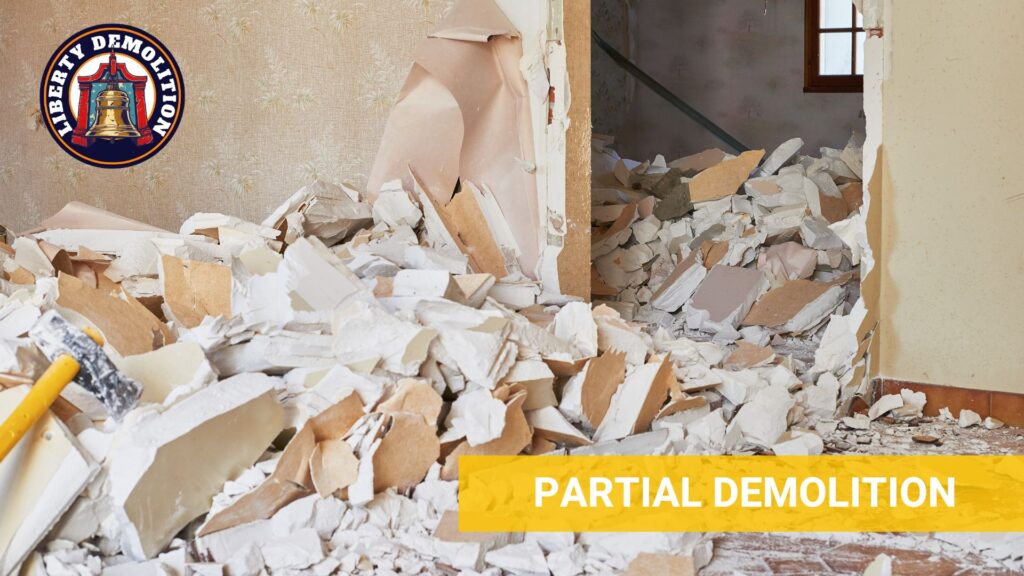
Understanding Partial Demolitions
Demolition doesn’t always equate to a complete teardown of an entire structure. In various circumstances, only specific parts or components of a house may need removal. This method, termed partial demolition, focuses on dismantling select portions of a property while preserving the remainder intact.
Cost Estimates for Various Partial Demolitions
Swimming Pools
Removal of in-ground pools demands intricate care due to their reinforced structure. The typical cost fluctuates from an average of $6,500 to upwards of $19,000 for expansive or multi-layered pools.
Decks
Ground-level decks may cost around $30 per square foot for removal, while elevated ones, which are more intricate, could range from $45 to $50 per square foot.
Chimneys
Costs can range from $4,000 to $10,000. Integral chimneys that extend into the house’s foundation would be on the pricier end.
Sheds and Barns
A general backyard shed demolition may cost between $50 and $100 per hour, contingent upon accessibility and complexity.
Roofs
Depending on the roof’s condition and design, costs might range from $4 to $5 per square foot.
Driveways
Despite seeming easy to demolish, driveways are robust structures, and their removal demands a meticulous process.
Foundation
While removal might cost between $1,000 and $5,000, it’s worth noting that rebuilding would involve additional expenses.
Interior Demolition
For homeowners seeking to reconfigure the internal structure without altering the exterior, this option, priced between $1,200 and $5,000, allows for a fresh interior layout.
Total Demolition
This procedure goes beyond just clearing out specific segments and aims at completely eradicating the building from its site. Here are the factors that influence the total demolition costs:
Size of the House
Naturally, the larger the property, the higher the cost. The price range typically falls between $2 and $17 per square foot.
Complexity and Features
Houses with intricate designs, multiple levels, or specialized materials might escalate the overall cost of demolition.
Labor Costs
Total demolition demands a crew with specialized skills. This ensures the safe operation of heavy machinery and adherence to safety protocols.
Permits
Acquiring the necessary permissions is a prerequisite before undertaking a total demolition. The cost of these permits can vary based on location and the nature of the house being demolished.
Time and Machinery
Though a total demolition typically progresses faster than its counterpart, deconstruction, it necessitates a different set of tools and expertise. Heavy machinery, often hydraulic in nature, is deployed to efficiently dismantle large sections of the building. The machinery not only expedites the process but also ensures a systematic and controlled takedown.
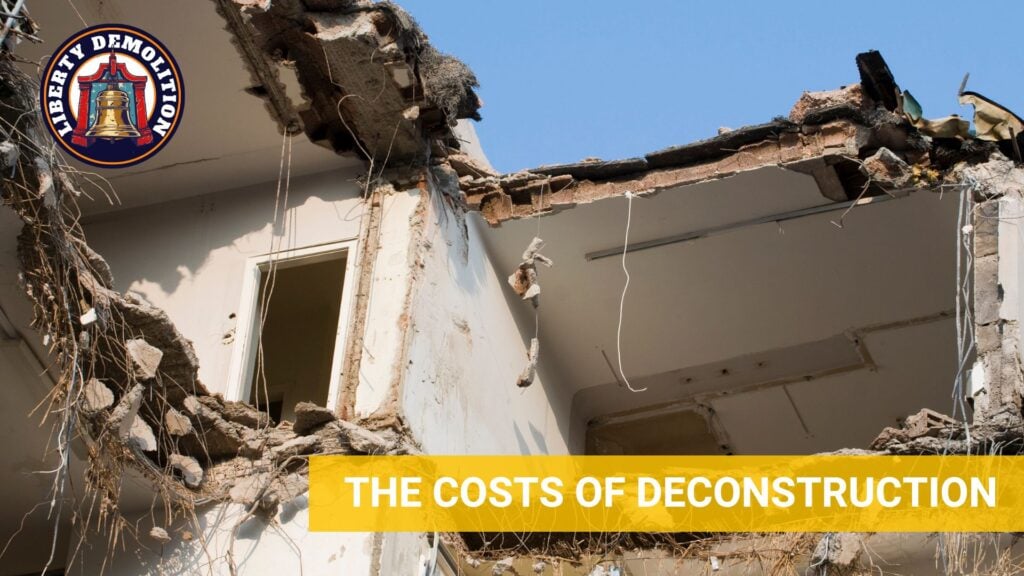
The Costs of Deconstruction
Instead of utilizing heavy machinery to tear down a structure, deconstruction focuses on preserving and reclaiming building materials.
Deconstruction places an emphasis on careful removal and ensures items such as cabinets, wiring, and architectural features remain intact. This detailed process naturally consumes more time and requires skilled labor, which can increase the overall cost.
Unlike standard demolition, where materials are typically discarded, deconstruction salvages materials like cast-iron tubs and cabinetry. This preservation not only extends the lifecycle of these items but can also mitigate the need for newer resources.
Homeowners engaging in deconstruction may discover that the materials they save have significant resale value. Alternatively, by donating these salvaged materials, they might be eligible for tax benefits. In some cases, the tax credits derived from such donations can be substantial, offsetting some of the initial deconstruction costs.
Deconstruction doesn’t always involve removing the foundation. If homeowners decide to retain it, there might be an added expense for its standalone deconstruction later on.

How to Save Money on Tearing Down a House
Demolishing a house can be expensive, but there are strategies homeowners can employ to minimize costs.
DIY Interior Deconstruction
While a complete house demolition may require specialized equipment, homeowners can do some tasks on their own. Stripping the interior by removing easily accessible fixtures like cabinets, light fixtures, doors, and tiles can help significantly reduce labor costs when professionals arrive.
Rally a Team
Enlisting the assistance of friends and family can prove beneficial. Not only does it make the deconstruction process faster, but some might be interested in salvaging specific materials, further reducing waste and hauling expenses.
Salvage and Resale
Many items extracted during the deconstruction process, from wood beams to vintage tiles, might hold resale value. Homeowners can consider selling these items to specialty shops, used furniture stores, or online platforms. This approach not only offsets some costs but also promotes sustainability.
Collaborate with the Fire Department
It might sound unconventional, but many local fire departments conduct live burn training exercises using real structures. Offering your house as a training ground might result in the fire department burning it down, thus reducing demolition work.
This action could be considered a charitable donation, potentially providing homeowners with tax benefits. Post-burning, homeowners would only need to handle the removal of the remaining debris, which is often considerably less in volume.
Donate Reusable Materials
Some organizations accept donations of construction materials, fixtures, and fittings, often providing a pickup service. This method can help reduce the disposal cost and might also qualify homeowners for tax deductions.
Get Multiple Quotes
As with any significant project, it’s wise to solicit quotes from multiple demolition contractors. This will allow homeowners to compare prices and services to make sure they get the best value for their money.
Understand Local Regulations
Familiarizing oneself with local regulations and permit fees can prevent unexpected costs and penalties. Some municipalities might even offer grants or incentives for certain types of demolitions or waste disposal methods.
Recycle and Repurpose
Recycling materials like concrete, metal, and certain types of wood can help in reducing dump fees. Additionally, repurposing materials for other home projects is both cost-effective and environmentally friendly.

How Much Does It Cost to Demolish a House – FAQs
What factors influence the demolition cost?
Several factors can affect the cost:
- Labor Rates. Local labor rates play a significant role in overall costs.
- Complexity. Houses with intricate designs, multiple stories, or hazardous materials like asbestos can increase costs.
- Permits. Some municipalities may have higher permitting fees than others.
- Accessibility. If the house is located in a densely populated area with limited access, the costs may be higher.
- Disposal Fees. Depending on the locality, disposing of the debris can vary in price.
How much does it cost to demolish a 2,000-square-foot house?
The cost of demolishing a house varies based on several factors. For a 2,000-square-foot house, you could expect a cost range between $4,000 to $34,000, assuming a rate of $2 to $17 per square foot. This range is influenced by labor rates, complexity of the demolition, permits, accessibility, and local disposal fees.
How long does it typically take to demolish a 2,000-square-foot house?
Demolishing a 2,000-square-foot house can typically take anywhere from a few days to a couple of weeks, depending on various factors.
What variables affect the timeline of a demolition?
Several variables can influence the duration:
- Method. Total demolition is generally quicker than deconstruction.
- Equipment Used. The type and efficiency of machinery can affect the speed.
- Complexity. Houses with more intricate designs or structures may take longer.
- Crew Size. A larger crew can expedite the process.
- Permitting and Inspections. Waiting for necessary approvals can introduce delays.
Is it more cost-effective to demolish or remodel a house?
The answer varies based on individual circumstances. Here are some factors to consider:
- Repair Costs. If the cost of necessary repairs approaches or exceeds the value of the home, demolition and rebuilding might be more economical.
- Building Code Compliance. Older homes may require extensive updates to meet current codes, which can be expensive.
- Customization. Demolishing and rebuilding allow for more customization than remodeling.
- Historical or Sentimental Value. Some might opt for remodeling to preserve the character or sentimental value of a house.
Ready for a Change? Choose Eco-Friendly Demolition Today!
Tearing down a house, whether due to damage or the desire for a fresh start, involves several considerations. Costs, methods, reasons, and the decision to do it yourself or hire professionals are all important factors. Regardless of your circumstances or needs, the demolition process is complex and demands attention to detail. As with any significant project, ensuring safety, complying with regulations, and adopting environmentally responsible practices should be at the forefront.
If you’re contemplating a demolition, it’s crucial to collaborate with professional demolition contractors who understand the difficulties of the task and uphold the highest standards of service. At Liberty Demolition, we’re not just in the business of tearing down structures; we’re dedicated to offering comprehensive demolition solutions that prioritize safety, environmental responsibility, and customer satisfaction.
Our diverse range of services, from residential to industrial, and our commitment to efficient waste management and recycling, ensures that your demolition needs are addressed in the most eco-friendly manner possible.
Choose Liberty Demolition and experience the seamless integration of professionalism, efficiency, and environmental consciousness. Can us for a free quote today!
